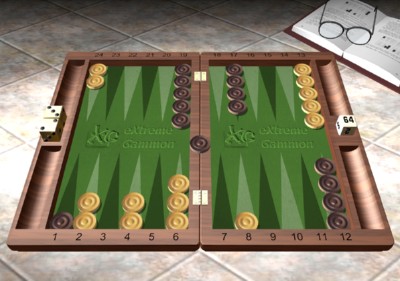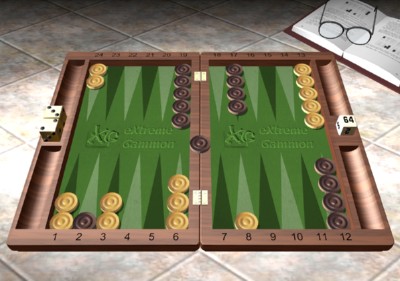Cash game, center cube.

Should White double? If he doubles, should Black take or drop?
A key idea in understanding the proper use of the doubling cube on a practical level is that of the “benchmark” position. A benchmark cube situation is a position where one of the decisions (doubling or taking) is a toss-up, while the other is completely clear. Properly understanding a benchmark position is very useful since it unlocks the key to many related positions. Just compare your actual position to the benchmark, spot what the relevant differences, and you should be able to make a good cube decision over the board. Better players are aware of hundreds of good benchmarks, so they can make their over-the-board decisions quickly and accurately.
This position shows an excellent benchmark situation. Black started the game with a 5-1, splitting his back men, and White responded with a 4-4, making two inner-board points. (Not best, by the way; making the 20-point and the 9-point is better, with a more enduring positional edge.) Black then danced, and White is now contemplating a double.
A rollout indicated that the double/no double decision was in fact just a small double. If doubling is theoretically close, then taking is, of course, hugely correct. Dropping is a mistake costing almost one-third of a point. (As a practical matter, this means that doubling is mandatory, since it’s theoretically slightly and might prompt a huge blunder on your opponent’s part.)
Once we recognize this position as a benchmark position for early blitzes where White has made a couple of points and Black has a checker on the bar plus a blot in White’s board, we can use it to analyze related positions. For instance, take a look at Position A:

Position A: Should White double? Should Black take?
In this case, Black again opened with a 5-1 but this time White responded with a 5-5, making two inner points. (The correct play in this case.) Again, White is thinking about doubling. Let’s compare the two positions and see what we should do.
First, we note that if our benchmark position was a trivially easy take for Black, this must be also. The two positions just aren’t different enough to swing this to a pass. So we’re certain Black should take, and now we’ll look at the double.
This new position differs from our benchmark in two ways, one favoring White, the other favoring Black. The factor favoring White is tactical, the factor favoring Black is strategic.
White is favored because he has two numbers to hit Black’s last blot (sixes and fours) instead of just one number (fives) in the benchmark position. The extra direct shot means that White has a slightly better chance of closing Black out.
Black is favored because White’s two inner board points are deeper, and the ace-point is in fact behind Black’s blot. As a result, when Black does anchor White will have some checkers out of play, so his alternative game plan of priming Black isn’t nearly as strong. In our benchmark position, all White’s checkers are still in front of Black’s blot, so if a blitz doesn’t work, White still has chances of building a prime.
Which feature is more important? In fact, White completes a closeout less than 30% of the time in either position, so the long-term aspects of the position matter most. In the benchmark position, White can play quietly for the prime, taking chances only when he rolls very well. In Position A, White has to go for the closeout, but he stands somewhat poorly whenever Black survives. White is actually substantially worse off in Position A, so the theoretically correct play there is no double. (The correct play over the board against anyone but a top player is to double, for the same reason as before; many players are afraid of blitz positions and will pass them without much thought.)





